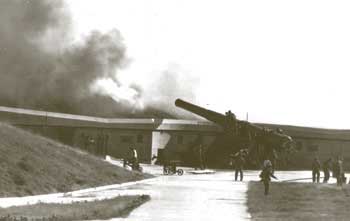|
Battery Osgood - Farley
Home of the Fort MacArthur Museum
Battery Osgood-Farley was constructed
during the years 1916-1919 under the fortification program
outlined by the Taft Board Report of 1906. Although
constructed as a single two-gun emplacement, each gun was
originally designated as a separate tactical battery, hence
the two names. Later, the battery was considered to be a
single tactical unit.
These 14-inch disappearing guns could fire a 1560 pound
projectile fourteen miles out into the Catalina Channel.
Full caliber firing
|

Battery Osgood beginning to recoil during a practice
firing
|
|
practice was rare, however,
because of the damage caused by the concussions to nearby
residences. Battery Osgood's gun was fired only 116 times
and Battery Farley's fired 121 times. Even though the
disappearing carriages of Battery Osgood-Farley were
considered to be obsolete by the mid-1920s, they remained in
active service until they were replaced by new ordnance in
the mid-1940s. A section of Battery Osgood-Farley was
gas-proofed during World War Two for use as a radio station
and fire control switchboard room. Battery Osgood-Farley's
guns were declared surplus in 1944 and cut up for scrap
sometime after 1946.
The Army continued to use the rooms and corridors of the
battery for various purposes with little modification until
1974. While the guns and some of the electrical equipment
were removed, much of the rest of the hardware such as the
doors, gates, electrical and plumbing services were left
intact.
This is in marked contrast to many of the other modern era
(post-1890) gun emplacements around the nation, which have
been gutted of all metal, wiring and plumbing by the Army,
humidity and vandals. Battery Osgood-Farley may be the best
preserved example modern age coastal defense gun emplacement
in the United States today. The Army recognized the
historical significance of Battery Osgood-Farley and placed
it on the Register of National Historical Places in 1976.
The Fort MacArthur Museum was established at Battery Osgood
- Farley in 1985 and is dedicated to the preservation and
interpretation of the history of Fort MacArthur. Fort
MacArthur’s reservations hold an important collection of
historical structures tied to the U.S. Army’s role in the
defense of the American continental coastline from invasion.
These structures, which are interpreted at the museum,
clearly define the development of American coastal defenses,
from the all-gun era at the turn of the twentieth century,
to the modern missile era of today.
|
|
Battery
Osgood is named for Brigadier General Henry Brown Osgood Jr.
(1843 – 1909). General Osgood began his military career with the 27th Maine during
the civil war. In July of 1861 at the end of their term of
enlistment, 312 members of the 27th Maine volunteered to
stay on to protect Washington D.C. from attack by rebel
forces and to wait for the outcome of the battle of
Gettysburg. For this action, all 299 members were awarded
the Congressional Medal of Honor. In 1916 congress was
tasked with reviewing all of the Medal of Honor citations
made prior to that time. At the conclusion of this review,
Congress decided that many of the medals had not been
justified under the rules for the award, and rescinded all
of the medals issued to the 27th Maine, Including
the one to General Osgood.
Henry Osgood was appointed to the US Military Academy at
West Point by President Abraham Lincoln and graduated with
the class of 1867. He went on to a full career with the army
and retired in 1908. General Osgood is buried in the
Hillside Cemetery overlooking Stephentown
New York. |
|
|
Battery Farley is named for Brigadier General Joseph
Pearson Farley (1839-1912). Appointed to the US
Military Academy at West Point by President Franklin
Pierce, he graduated with the class of 1861. As a
Lieutenant, Farley served as Ordinance Officer at
Watertown Arsenal from 1861 to 1863 during which time
he proved more than 600 guns produced by the arsenal
during that time.
During the Civil War, Farley distinguished himself
during operations against Charleston, Morris Island,
and the bombardment of Fort Wagner. After the war,
Farley continued to serve with the Ordinance
Department in key roles at various arsenals including,
Rock Island, Springfield, Kennebec, Frankford, and as Commanding Officer at Watervliet; his
last service before retirement.
In 45
years of service, General Farley was constantly
commended by his superiors for his exemplary
performance and cheerful attitude toward his duties.
General Farley was laid to rest in the cemetery at
West Point on
April
8th 1912 with full military honors.
|
|
|
 |
|
The Guns of Fort MacArthur |
 |
|
|
|